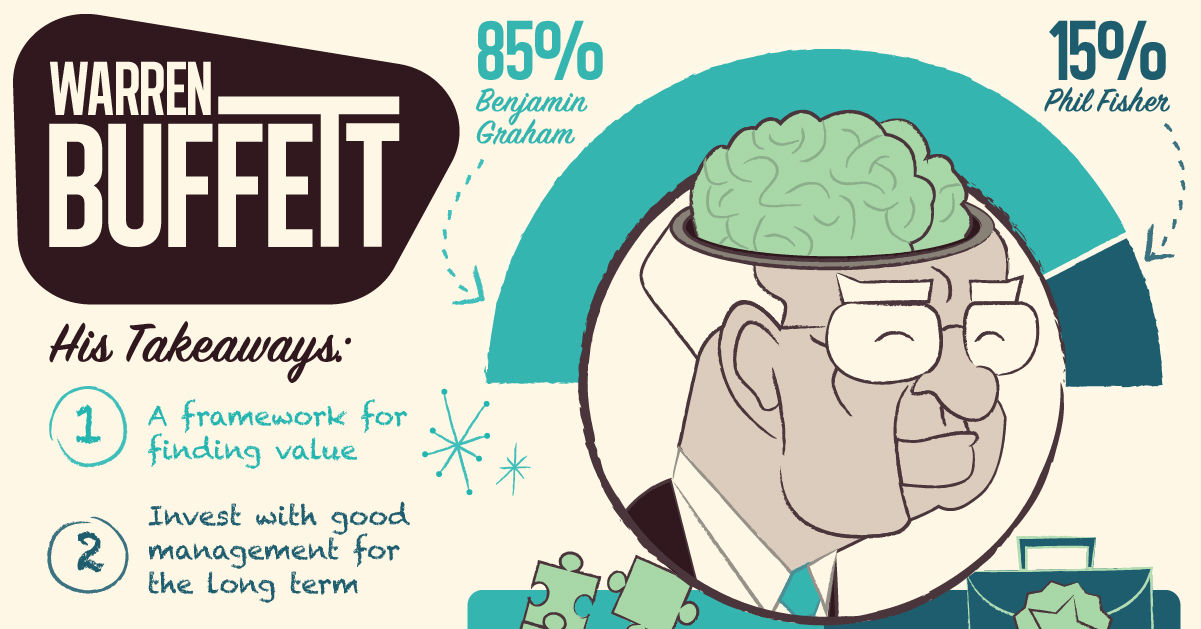Markets
Inside Warren Buffett’s Brain
What springs to mind when you think of legendary investor Warren Buffett?
For some, it’s his humble Omaha origins or his long-lasting obsession with Coca-Cola. For other people, it’s Buffett’s impeccable investing track record and extraordinary wealth that make a lasting impression.
While these are all legitimate connections to make with the Buffett name, perhaps he is most synonymous with the discipline of value investing – the style and mindset Buffett has made famous over the decades.
The Warren Buffett Series
Part 2: Inside Buffett’s Brain
Today’s infographic provides a deep dive into Warren Buffett’s brain, and it explains everything about his investing philosophy, along with the framework he uses to evaluate potential opportunities.
It’s the second part of the Warren Buffett Series, which we’ve done in partnership with finder.com, a personal finance site that helps people make better decisions – whether they want to jump on the cryptocurrency craze or follow Buffett’s more traditional path to financial success.

Note: Stay tuned for future parts with our free mailing list.
Warren Buffett’s investment philosophy is well-known.
He famously focuses on the intrinsic value of companies, and he buys stocks when they are “on sale”. Buffett’s not afraid to accumulate big positions in companies he likes – and his favorite holding period is “forever”.
While this formula may seem simple on paper, it’s extremely nuanced and complex in practice.
How Does Buffett’s Brain Work?
Warren Buffett has said that he borrows 85% of his investing style from Benjamin Graham, and 15% from Phil Fisher.
Benjamin Graham:
The godfather of value investing gave Buffett a framework for finding undervalued assets and companies.
Phil Fisher:
The famous growth investor showed Buffett the importance of investing with good management teams.
According to writer Robert Hagstrom, Buffett applies these ideas by focusing on four key principles of investing:
1. Analyze a stock as a business
Have the priorities of a business owner and look the company from a long-term perspective.
Is it increasing its intrinsic value? Would you want to own the entire company?
2. Ensure a “margin of safety”
Buffett considers “margin of safety” the three most important words in investing.
In other words, does a company have more intrinsic value than book value?
3. Manage a focused portfolio
Concentrate on a few stocks that will provide above-average returns over time. Buffett suggests investors think of this as owning a “punch card” with just 20 investment choices that can be made over a lifetime.
4. Protect yourself from Mr. Market
Mr. Market can be speculative and emotional, and he should not be relied upon as a predictor of future prices.
Instead, take advantage of Mr. Market periodically, whenever there is a fire sale.
Buffett’s Investment Criteria
Here are 12 key factors Warren Buffett considers when looking at potential opportunities:
1. Simplicity
Is the business easy to understand?
2. Operating History
Has the business been around for a long time, with a consistent operating history?
3. Long-Term Prospects
Is there reason to believe that the business will be able to sustain success in the long-term?
4. Rational Decisions
Is management wise when it comes to reinvesting earnings or returning profits to shareholders as dividends?
5. Candidness
Does the management team admit mistakes? Are they honest with shareholders?
6. Resisting the “Institutional Imperative”
Can the company resist temptations created by institutional dynamics, such as imitating peer companies, or resist changes in direction?
7. Profit Margins
Does the company have high profit margins?
8. Return on Equity
What is the return on equity (ROE) of the business?
9. Owners Earnings
What is the company’s ability to generate cash for shareholders, who are the residual owners? This is technically defined as free cash flow to equity (FCFE).
10. One Dollar Premise
For every dollar retained from net income, does the company create at least one dollar of market value?
11. Intrinsic Value
What is the value of the future owners’ earnings, discounted back to the present?
12. Margin of Safety
What’s the chance you’ll lose money on the stock, in the long run, if you buy it at today’s price?
Or to sum all of these ideas up succinctly, here’s a quote from the man himself.
My strategy is to find a good business – and one that I can understand why it’s good – with a durable, competitive advantage, run by able and honest people, and available at a price that makes sense.
– Warren Buffett
Other Notes
Part 3 of the Warren Buffett Series will be released in late February 2018.
Credits: This infographic would not be possible without the great biographies done by Roger Lowenstein (Buffett: The Making of an American Capitalist) and Alice Schroeder (The Snowball), as well as numerous other sources cataloging Buffett’s life online.
Markets
The European Stock Market: Attractive Valuations Offer Opportunities
On average, the European stock market has valuations that are nearly 50% lower than U.S. valuations. But how can you access the market?

European Stock Market: Attractive Valuations Offer Opportunities
Europe is known for some established brands, from L’Oréal to Louis Vuitton. However, the European stock market offers additional opportunities that may be lesser known.
The above infographic, sponsored by STOXX, outlines why investors may want to consider European stocks.
Attractive Valuations
Compared to most North American and Asian markets, European stocks offer lower or comparable valuations.
| Index | Price-to-Earnings Ratio | Price-to-Book Ratio |
|---|---|---|
| EURO STOXX 50 | 14.9 | 2.2 |
| STOXX Europe 600 | 14.4 | 2 |
| U.S. | 25.9 | 4.7 |
| Canada | 16.1 | 1.8 |
| Japan | 15.4 | 1.6 |
| Asia Pacific ex. China | 17.1 | 1.8 |
Data as of February 29, 2024. See graphic for full index names. Ratios based on trailing 12 month financials. The price to earnings ratio excludes companies with negative earnings.
On average, European valuations are nearly 50% lower than U.S. valuations, potentially offering an affordable entry point for investors.
Research also shows that lower price ratios have historically led to higher long-term returns.
Market Movements Not Closely Connected
Over the last decade, the European stock market had low-to-moderate correlation with North American and Asian equities.
The below chart shows correlations from February 2014 to February 2024. A value closer to zero indicates low correlation, while a value of one would indicate that two regions are moving in perfect unison.
| EURO STOXX 50 | STOXX EUROPE 600 | U.S. | Canada | Japan | Asia Pacific ex. China |
|
|---|---|---|---|---|---|---|
| EURO STOXX 50 | 1.00 | 0.97 | 0.55 | 0.67 | 0.24 | 0.43 |
| STOXX EUROPE 600 | 1.00 | 0.56 | 0.71 | 0.28 | 0.48 | |
| U.S. | 1.00 | 0.73 | 0.12 | 0.25 | ||
| Canada | 1.00 | 0.22 | 0.40 | |||
| Japan | 1.00 | 0.88 | ||||
| Asia Pacific ex. China | 1.00 |
Data is based on daily USD returns.
European equities had relatively independent market movements from North American and Asian markets. One contributing factor could be the differing sector weights in each market. For instance, technology makes up a quarter of the U.S. market, but health care and industrials dominate the broader European market.
Ultimately, European equities can enhance portfolio diversification and have the potential to mitigate risk for investors.
Tracking the Market
For investors interested in European equities, STOXX offers a variety of flagship indices:
| Index | Description | Market Cap |
|---|---|---|
| STOXX Europe 600 | Pan-regional, broad market | €10.5T |
| STOXX Developed Europe | Pan-regional, broad-market | €9.9T |
| STOXX Europe 600 ESG-X | Pan-regional, broad market, sustainability focus | €9.7T |
| STOXX Europe 50 | Pan-regional, blue-chip | €5.1T |
| EURO STOXX 50 | Eurozone, blue-chip | €3.5T |
Data is as of February 29, 2024. Market cap is free float, which represents the shares that are readily available for public trading on stock exchanges.
The EURO STOXX 50 tracks the Eurozone’s biggest and most traded companies. It also underlies one of the world’s largest ranges of ETFs and mutual funds. As of November 2023, there were €27.3 billion in ETFs and €23.5B in mutual fund assets under management tracking the index.
“For the past 25 years, the EURO STOXX 50 has served as an accurate, reliable and tradable representation of the Eurozone equity market.”
— Axel Lomholt, General Manager at STOXX
Partnering with STOXX to Track the European Stock Market
Are you interested in European equities? STOXX can be a valuable partner:
- Comprehensive, liquid and investable ecosystem
- European heritage, global reach
- Highly sophisticated customization capabilities
- Open architecture approach to using data
- Close partnerships with clients
- Part of ISS STOXX and Deutsche Börse Group
With a full suite of indices, STOXX can help you benchmark against the European stock market.

Learn how STOXX’s European indices offer liquid and effective market access.

-

 Economy2 days ago
Economy2 days agoEconomic Growth Forecasts for G7 and BRICS Countries in 2024
The IMF has released its economic growth forecasts for 2024. How do the G7 and BRICS countries compare?
-

 Markets1 week ago
Markets1 week agoU.S. Debt Interest Payments Reach $1 Trillion
U.S. debt interest payments have surged past the $1 trillion dollar mark, amid high interest rates and an ever-expanding debt burden.
-

 United States2 weeks ago
United States2 weeks agoRanked: The Largest U.S. Corporations by Number of Employees
We visualized the top U.S. companies by employees, revealing the massive scale of retailers like Walmart, Target, and Home Depot.
-

 Markets2 weeks ago
Markets2 weeks agoThe Top 10 States by Real GDP Growth in 2023
This graphic shows the states with the highest real GDP growth rate in 2023, largely propelled by the oil and gas boom.
-

 Markets2 weeks ago
Markets2 weeks agoRanked: The World’s Top Flight Routes, by Revenue
In this graphic, we show the highest earning flight routes globally as air travel continued to rebound in 2023.
-

 Markets2 weeks ago
Markets2 weeks agoRanked: The Most Valuable Housing Markets in America
The U.S. residential real estate market is worth a staggering $47.5 trillion. Here are the most valuable housing markets in the country.
-

 Energy1 week ago
Energy1 week agoThe World’s Biggest Nuclear Energy Producers
-

 Money2 weeks ago
Money2 weeks agoWhich States Have the Highest Minimum Wage in America?
-

 Technology2 weeks ago
Technology2 weeks agoRanked: Semiconductor Companies by Industry Revenue Share
-

 Markets2 weeks ago
Markets2 weeks agoRanked: The World’s Top Flight Routes, by Revenue
-

 Countries2 weeks ago
Countries2 weeks agoPopulation Projections: The World’s 6 Largest Countries in 2075
-

 Markets2 weeks ago
Markets2 weeks agoThe Top 10 States by Real GDP Growth in 2023
-

 Demographics2 weeks ago
Demographics2 weeks agoThe Smallest Gender Wage Gaps in OECD Countries
-

 United States2 weeks ago
United States2 weeks agoWhere U.S. Inflation Hit the Hardest in March 2024




















